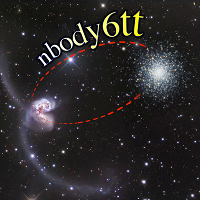
 nbody6tt
nbody6tt
Description of the code
nbody6tt is based on nbody6 by Sverre Aarseth and includes the treatment of complex galactic tides in a direct N-body simulation of a star cluster, through the use of tidal tensors (tt). nbody6tt actually gathers two complementary methods:
Mode A: the tidal information is extracted from a galaxy or cosmology simulation, in the form of tidal tensors, along one orbit. This information is stored in a file. In a second step, nbody6tt runs a simulation of the cluster, reads the file, and computes the tidal acceleration. This method is described in .
Mode B: the user defines a numerical function which takes position and time as arguments, and returns the galactic potential. The space and time derivatives of the potential are used to (i) integrate the motion of the cluster on its orbit in the galaxy (starting from user-defined initial position and velocity vector), and (ii) compute the tidal acceleration on the stars. This method is described in .
The advantage of Mode A is the versatility: any kind of galaxy and orbit can be considered, even complex ones. For example, we used it to model star clusters in galaxy mergers (). However, Mode A relies on the tidal approximation (linearisation of the tidal force), and thus cannot be used to study tidal debris. Mode B is not limited by this, and does not require a galaxy simulation. (We used Mode B in )
Which mode should you use?
Do you plan to study tidal debris (tails)?
If yes, use mode B! If no, consider the next question.
Can you describe the galactic potential with a fortran function?
If yes, use mode B! If no, you should run a galaxy simulation, extract the tidal tensors and use Mode A.
What to do if you want to study tidal tails but cannot describe the potential with a fortran function?
Keep dreaming. I will wake you up in a few months when this will become possible! (work in progress)
Download
Download the sources from GitHub.
Reference should be made to and/or , and a nice email is always appreciated!
Help, feedback
Questions, bug reports, comments and suggestions are most welcome: florent.renaud<at>gmail.com
Examples of tidal tensors
You want to try nbody6tt but you don't have a galaxy simulation? First, consider using it with MODE B (since v4.0, see above). Or you can use one of the tidal tensor files provided below. (I used them for the nbody6tt simulations presented in .) Download one of these files and rename it "tt.dat". In the input parameters, set KZ(14) to 9, and run nbody6tt!
| tt.dat_pt_circ_r1000 | Circular orbit at 1 kpc from a point-mass galaxy of 1010M⊙(named "Orbit A" in Renaud et al. 2011, Fig.5) |
| tt.dat_pt_circ_r3000 | Circular orbit at 3 kpc from a point-mass galaxy of 1010M⊙(named "Orbit B" in Renaud et al. 2011, Fig.5) |
| tt.dat_pt_ellip_e0.5 | Elliptical orbit of pericenter 1 kpc and apocenter 3 kpc (eccentricity = 0.5) around a point-mass galaxy of 1010M⊙(named "Orbit C" in Renaud et al. 2011, Fig.5) |
| tt.dat_plummer_extensive | Circular orbit at the caracteristic radius of Plummer potential(named "xi = 1" in Renaud et al. 2011, Fig.7) |
| tt.dat_plummer_compressive | Circular orbit at 0.66 caracteristic radius of Plummer potential(named "xi = 0.66" in Renaud et al. 2011, Fig.7) |
| tt.dat_antennae_orbitB | Orbit in the Antennae galaxies(see Fig.8 of Renaud et al. 2011, and orbit B in Fig.8 of ) |
| tt.dat_ngc4038_orbitB | Same as before, but without the second galaxy colliding(see Fig.8 of Renaud et al. 2011) |
 About me
About me CV
CV Academic CV
Academic CV Publications
Publications Talks
Talks Simulations
Simulations Movies
Movies Milky Way
Milky Way Codes
Codes rdramses
rdramses QuickADS
QuickADS